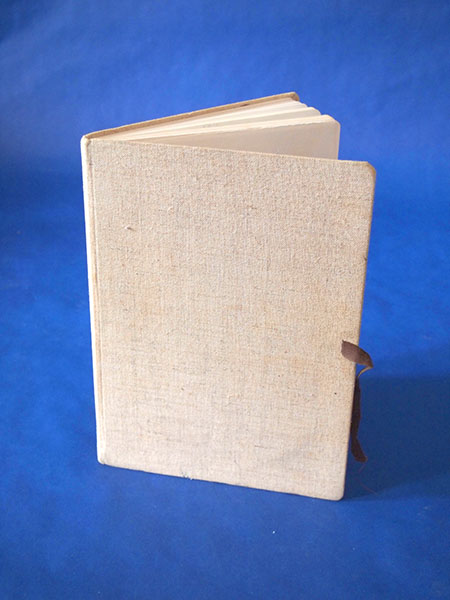![]() body | color | collections | commodity | cube | document | fabric | fetish | gender | glass | home | identity | living | machine | metal | minimal | mobility | narrative | olfactory | organic |
body | color | collections | commodity | cube | document | fabric | fetish | gender | glass | home | identity | living | machine | metal | minimal | mobility | narrative | olfactory | organic |
![]() pain | paper | plastic | plugs | power | protective | rectangular | ritual | round | sound | souvenir | spiritual | style | text-based | time | tool | touch | uniform | value | visual | warm | wood
pain | paper | plastic | plugs | power | protective | rectangular | ritual | round | sound | souvenir | spiritual | style | text-based | time | tool | touch | uniform | value | visual | warm | wood
| Paper: Cloth Notebook | |||
Narrative: Cloth notebook The paper was made from pulp obtained by chemical means, known as kraft pulping. Chips of wood were placed in a large, sealed container known as a digester. The digester contained a strongly alkaline solution of sodium hydroxide and sodium sulfide. Bleaching removes lignin and involves mixing the pulp with a series of oxidizing chemicals that react with the lignin. After each mixture, the pulp was washed with an alkaline solution that removes the treated lignin. Fillers were added to the pulp. (A typical filler is a clay known as kaolin. Other chemicals often added to pulp include starches or gums. Rosin and alum are often added as sizers, making the paper less absorbent.) Pulp was added to water to form slurry in order to make paper with an even density. The slurry was pumped onto a moving mesh screen made up of very fine wires of metal or plastic. Water drained through the small openings in the mesh, and formed a sheet of wet material from the slurry. The sheet was moved on a series of belst made of felt containing wool, cotton, and synthetic fibers. The dried sheets moved between rollers known as calendars to make it smooth. Cultivators rip out weeds and grass that may compete with the cotton for soil nutrients, sunlight, and water, and may attract pests that harm cotton. Land is plowed under and soil is broken up and formed into rows. Cottonseed is planted. The boll matures in a period that ranges from 55 to 80 days. Ten weeks after flowers first appeared, fibers split the boll apart, and cotton pushes forth. Most steps involved in the production of cotton have been mechanized, including seeding, picking, ginning, and baling. Samples are taken from the bales to determine the quality of the cotton. At this point the cotton plant is defoliated if it is to be machine harvested. Defoliation (removing the leaves) is often accomplished by spraying the plant with a chemical. It is important that leaves not be harvested with the fiber because they are considered "trash" and must be removed at some point. In addition, removing the leaves minimizes staining the fiber and eliminates a source of excess moisture. Some American crops are naturally defoliated by frost, but at least half of the crops must be defoliated with chemicals. Without defoliation, the cotton must be picked by hand, with laborers clearing out the leaves as they work. This notebook was given to me at a fellowship at Yale School of Art in 2001. I used this notebook during the summer and fall of 2001. It traveled with me from Connecticut to Brooklyn to Queens to storage. Then it was retrieved and traveled to Manhattan and Brooklyn. |
 |
||
![]()
